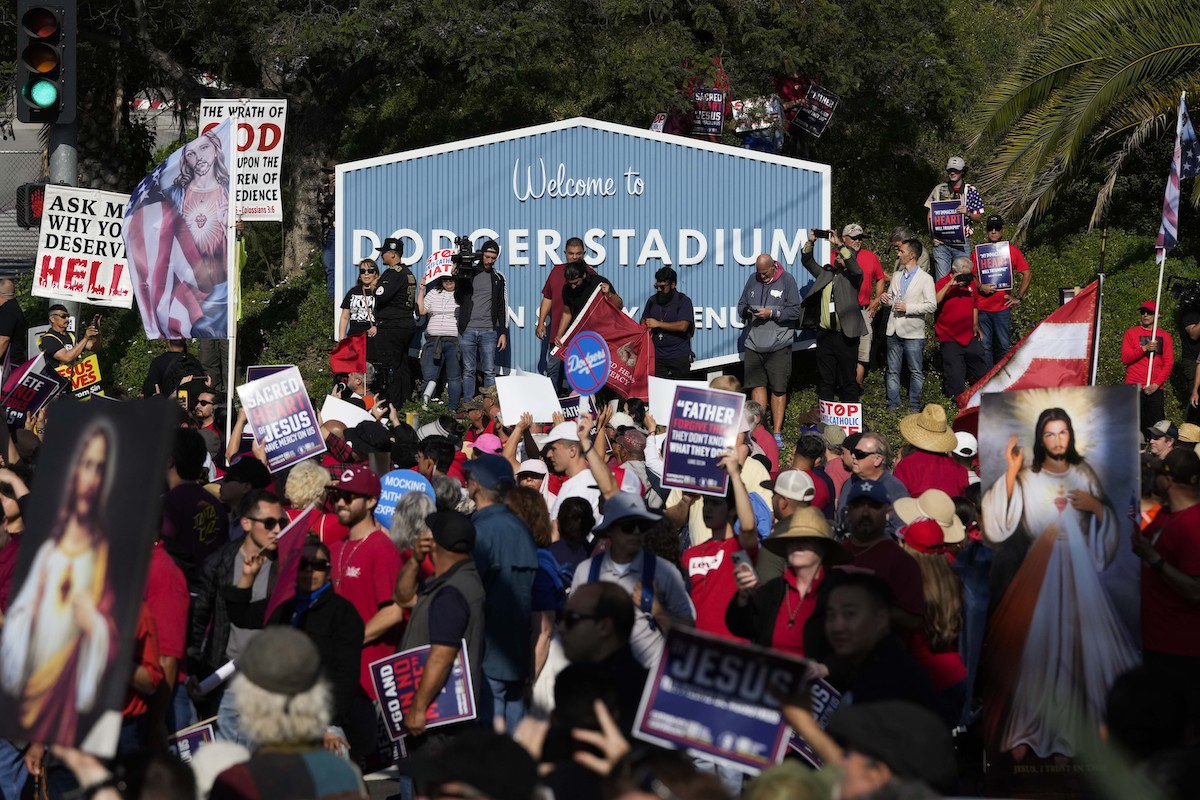On June 16, some 2,000 people gathered outside Los Angeles’ Dodger Stadium to protest the team’s having chosen to honor, on the field before that night’s game, a group whose core mission and purpose is the open mockery and parody of Catholicism. Several players noted their objections to the team’s choice, among them pitching ace Clayton Kershaw, who in the aftermath of the team’s decision to celebrate the group successfully lobbied Dodger leadership to let him announce a “Christian Faith and Family Day” for later in the season. A Los Angeles Times article quoted Kershaw as criticizing the decision to honor the group in June: “I don’t agree with making fun of other people’s religions. … I just don’t think that, no matter what religion you are, you should make fun of somebody else’s religion.”
While that statement was concise and clear, the columnist who penned the article found it necessary to add, just a few paragraphs later, that “Kershaw declined to offer specifics about … how he reconciles his stated belief ‘to love everybody’ with opposition to [the] group.” That the writer actually asserted that the player provided no explanation for his stance, mere sentences after having quoted that player’s explicit explanation for his stance, was as confounding as the clear implication that the paper stood not with the ballplayer who was opposed to mockery of religion but with those doing the mocking.
For Major League Baseball (MLB), though, controversy is nothing new. In fact, a recently published book on a significant historical episode in the game provides both an uplifting lesson on how sport can transcend scandal and a slightly more depressing message on how the dynamics of contemporary controversies are different from those of the past.
Dan Taylor’s Baseball at the Abyss, released this year, covers a tumultuous time in the game, from 1926 through 1927. Over that span, baseball’s first commissioner, Kenesaw Mountain Landis, and the league were confronted with a serious scandal that mirrored the infamous 1919 “Black Sox” World Series controversy of just a few years before. In 1926, revelations came to light that some of the league’s most prominent players were fixing and gambling on games. The high profiles of those implicated—Ty Cobb and Tris Speaker faced the most serious allegations, while rumors also swirled around Rogers Hornsby—made the news hard to ignore and contributed to widespread media outrage and condemnation. The game seemed to be a rotten scam, not to be trusted or attended by fans. To make matters worse, the sheer amount of rumor circulating and conflicting testimonies being raised meant that, despite his best efforts and a significant investigation into the most serious allegations, Landis was unable suspend or ban any players; they all returned to play in 1927.
Luckily for Landis and for the future of the MLB, there happened to be another player of even greater prominence at the time, one who had coincidentally undergone a profound transformation over the course of 1926–27 that allowed him to become, as described in the book’s subtitle, “the unlikely savior who rescued a tarnished game.” It is that player, one George Herman “Babe” Ruth of the New York Yankees, that serves as the protagonist of Taylor’s excellent book.
Taylor’s recounting of the ways in which Ruth was an “unlikely” savior makes for enjoyable reading. The Babe was a profligate gambler himself, although not to the extent that he bet on fixed baseball games. In one offseason that he spent in Cuba playing exhibition games, however, he lost all the money he earned there ($15,000) at the track, as well as $5,000 he brought for the specific purpose of laying bets and an additional $15,000 for which he had wired back home. His appetite was legendary: he was known to order four steaks in one sitting (with a “particular favorite” being “steak smothered in pork chops”), and a typical pregame snack consisted of up to six hot dogs with soda.
Of course, many of Ruth’s excesses were less amusing—and they all had their consequences. He was serially unfaithful to his first wife, resulting in the concoction of a false story about the adoption of a daughter and ultimately the destruction of the marriage. His gambling and excessive spending (on clothes, cars, and nightlife, but also on favored charitable causes) had left him broke by 1925. In spring training of that year, his consumption caught up with him in other ways: he had gained over 60 pounds since his entry into the league several years earlier, and during the preseason he collapsed twice. Ultimately, he underwent intestinal surgery and missed part of the regular season; when he did return, his play was subpar, with his home run total and batting average sinking as fan attendance in New York dwindled and the Yankees limped to a fifth-place finish.
While most of this material has been covered before, it is the aftermath of the 1925 season to which Taylor turns the reader’s attention; it was then that Ruth began to turn his career, and life, around. The story of how he did so, and the effects of his doing so, provides the core message and value of the book. At that time, Ruth came under the guidance of manager-agent Christy Walsh, who set the slugger on a path of reform in nearly every aspect of his life. The 1926 season saw a marked improvement in Ruth’s play and a return to the World Series for the Yankees (they ultimately lost that contest). With continued hard work and discipline, though, he entered the 1927 season in peak form, prepared to make a run at baseball’s record books just as the sport itself was suffering from a tremendous lack of public confidence in the wake of the Cobb-Speaker-Hornsby debacles.
Taylor delivers the story of that legendary season with thrilling detail, outlining Ruth’s pursuit of the all-time home run record (complete with a back-and-forth race for that record between the great slugger and a teammate, Lou Gehrig), as well as the Yankees’ campaign for the winningest season ever and a World Series title. Against the background of scandal and the loss of public support the game was facing, the author convincingly argues that Ruth may have saved the game itself in 1927. That may seem like a hyperbolic statement, but it is one supported by surprising facts; as just one example, teams across baseball saw steep declines in attendance that season, routinely recording live gate revenues that were double-digit percentages lower than the previous year, representing tens and sometimes hundreds of thousands less in cumulative ticket sales. The one bright spot was Ruth and his Yankees, ticket sales for which represented in excess of 30 (and in some cases forty) percent of home ticket revenues for at least five other teams in their own hometowns. In Boston, fully 47 percent of fans who attended a game in 1927 did so when the Yankees were the visiting team.
The economic impact of Ruth’s play in1927 was thus real and measurable. More than just sustaining the league’s solvency, the Babe’s ability to draw fans back signalled that they no longer associated the game with corruption. Rather, it was pure athletic achievement that brought the masses out to ballparks throughout 1927, with no hint of scandal or even much memory of the sins of the game’s recent past. (In a particularly interesting episode, Taylor recounts how an admittedly crooked player, in testimony before Commissioner Landis, explained which in-game statistics one could track to easily detect a rigged game. The home run numbers being stacked up by Ruth were not among them.)
Ruth’s heroics showed how sport itself can fix sporting leagues, providing current baseball fans hope that the MLB and individual teams’ ideological excesses can be checked by pure athletic greatness and competition. That said, there is a profound difference between Ruth’s time and today. In the 1920s, it was corrupt players who needed to be reined in by league executives, while media figures sought to hold those involved to standards of decency and integrity. In the 2020s, across professional sports, it is the excesses of team and league executives that need reining in, and players like Kershaw who speak out have to do so in the face of the resistance and slights from outlets like the Los Angeles Times.
This notwithstanding, one aspect of the recent events in Los Angeles bears remembering: while the Dodgers honored their chosen group before the start of that June game, there were few fans present in the almost empty stadium to see it, while thousands gathered outside to protest. Perhaps there is enough of a message there to remind MLB and team executives that it is always the fans that have the last word.

